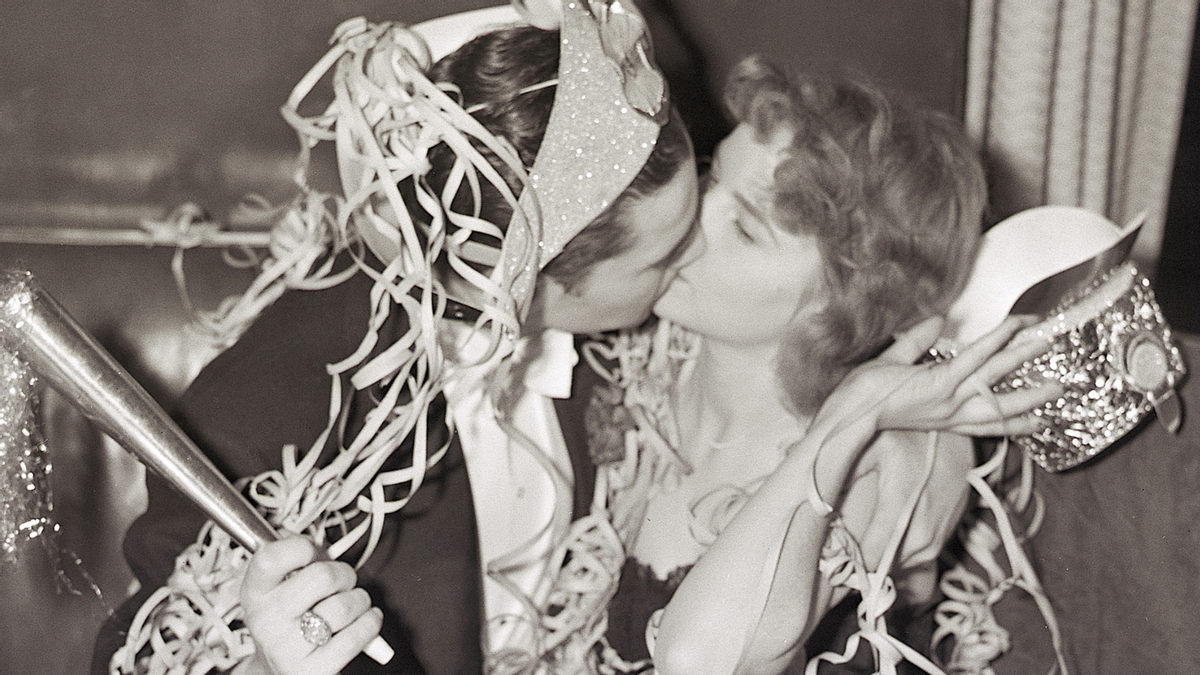When the ball drops in New York City’s Times Square to signify the arrival of the new year, many people will turn to their loved ones for a smooch as the noisemakers go off, confetti drops and “Auld Lang Syne” echoes through the streets.
Kissing is such a common tradition on New Year’s Eve that it’s been ratified in Hollywood movies, TV shows and fiction. Snopes has covered this topic in the past, but its popularity among readers necessitated further exploration of where this tradition might have come from.
Despite its ubiquity, the exact origins of the New Year’s kiss are unknown. Experts have pulled together theories that can be traced back to winter celebrations of the ancient Romans as well as the Vikings.
According to the culture publication Reader’s Digest:
Though the precise origins of puckering up the second a new year begins are unknown, the custom is often traced back to two winter festivals: Saturnalia, a pagan holiday in ancient Rome, and Hogmanay, a Viking tradition still celebrated on New Year’s in Scotland. Saturnalia was held annually during the winter solstice, and because it was the biggest party of the year, naturally it involved public drunkenness. Somehow that part morphed into the (likely correct) assumption that kissing was involved. Because Saturnalia was held between Dec. 17 and Dec. 23, experts believe that’s how the New Year’s kiss got its start. Hogmanay traditions, on the other hand, at least involve a New Year’s kiss. But these kisses were doled out to greet strangers and friends along with wishes of a “Guid New Year.”
Folklore expert Christina Fitzgerald told Reader’s Digest that “Sir Gawain and the Green Knight,” a late-14th century poem of Arthurian legend, is one of the first references to the concept of a New Year’s kiss in fiction. The related verse occurs early in the epic, describing a party in which the women are going to give “gifts” to the men. It reads:
When New Year was fresh and but newly come,
the court was served double on the dais.
As soon as the king with his knights was come into the hall,
the chanting in the chapel came to an end;
loud was the cry there of clerks and others.
Noel was celebrated anew, shouted full often;
and afterwards the great ones ran about to take handsel;
called aloud for New Year’s gifts;
ladies laughed full loud, though they had lost;
and he that won was not wroth, that may ye well trow.
Fitzgerald told Reader’s Digest it’s widely accepted that the gifts are meant to be kisses.
As far as the tradition gaining popularity in the modern United States, a 2018 Time magazine exploration of the subject cites an 1863 piece from The New York Times, one of the earliest media reports about the tradition.
The New York Times article suggests the influence of German immigrants on the spread of New Year’s traditions including kissing loved ones at midnight. It reads, in part:
New-Year’s Eve is a great time among the Germans, who assemble around the domestic fireside, in their public halls, their club houses, their theatres, their concert houses and their bier-knerpe, or minor beer cellars, to pass the waning hours of the old year, with music, song, the drama and the farce, good cheer and merriment. On that night, too, all their shops, of every description, are decked out in the most tempting manner with all the oddest and showiest wares, tricked off with flowers, real or artificial, and limitless wealth of evergreen…
All is happiness on the surface at least, and where there is sorrow it too takes counsel of hope for the coming year. Such is the German idea of the celebration of Sylvester Abend, of New Year’s Eve and the day that follows. New friendships are formed and cemented, old feuds are reconciled, fresh projects and matrimonial alliances started, and altogether, the back is turned upon the unpleasant things of the past, and a beaming countenance hails the new-born January. As the clocks ring out the hour of midnight, all this festivity pauses for a moment, to listen, and as the last stroke dies into silence, all big and little, old and young, male and female, push into each other’s arms, and hearty kisses go round like rolls of labial musketry, with the exclamation “Prost’s Neujahr!” (Hail the New-Year!) Gentlemen and ladies in the bloom of youth heartily approve this custom, and their venerable predecessors likewise seem to relish it, if ’twere only for the sake of “Auld Lang Syne!” Such was she picture in New-York on Wednesday night and Thursday. All the places of amusement were crowded, and in hundreds of private dwellings the mirthful usages of Fatherland were duly celebrated. The custom of shooting the old year out and the new one in, which is so popular in the German rural districts, was not so fully observed as heretofore, in this City, and the discharge of guns, cannon and squibs was not sufficient to attract very great attention.
Daniel Compora, another folklore expert, told Reader’s Digest that kissing someone at midnight could be considered either a tradition or a superstition depending on the beliefs of the kisser. Compora added, “Quite honestly, it sounds like an excuse to kiss people who may not otherwise allow you to do so.”
So whether you’re kissing someone because you think it’ll bring good luck in the new year or because it’s a family tradition passed down from Viking ancestors, make sure it’s consensual.
Snopes’ archives contributed to this report.
